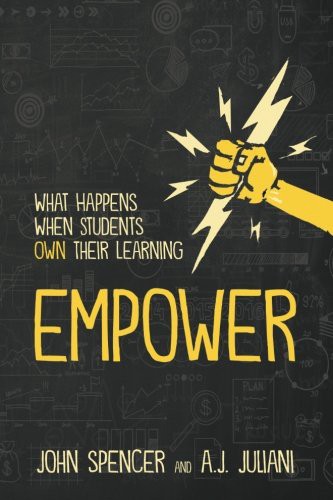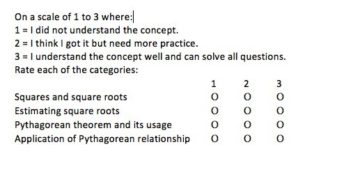
I decided to make Empower my first read of 2018 because it meant starting my reflective teacher journey with a book club. When John Spencer sent out the invite for it, I was thrilled and nothing could stop me from reading the book and subsequently discuss it with peers.
It is great book, one I would go back to in the future when I am in my own classroom and want ideas or reassurance that this path was going to be a hard one and the fact that I am trying is important.
What path am I talking about? It is empowering my students and to help them own their learning; to be a guide to them; to still follow the curriculum but give them the power to learn it in their own unique way and to prepare them for challenges that we have not thought of so far.
In the following sections, I present the thoughts and ideas that I had as I read the book. I have been a student of education for a couple of years now and Empower brought back many concepts that I am familiar with.
- I connected what I was reading to the teaching psychologies that I recently learned about.
- I often looked back at my own student life (which is all my life) to understand when certain changes happened to me.
- I asked myself about who I am as a teacher and what I can take away from the book and integrate into my teaching practices.
- I imagined how I would incorporate some of the techniques I was most excited about in my classroom and the subjects I will teach.
- I also thought about the Alberta curriculum and its own philosophy and how empowerment fits into it.
Sometimes I did not have answers to the questions I asked myself. Some answers that I wrote will develop more when I teach in my own classroom.
Educational Psychologies behind Empowerment
It is not about what we want students to learn, it is about what they learn through their choices in what they do (create, build, design, make, evaluate). — Empower, pg xxx
Educational psychology is the study of how people learn. The way we teach our students is rooted in the way we believe they learn — by punishment and rewards (behaviourism), by doing, creating, making (constructivism), by processing information (information processing) and so on.
Constructionism is the psychology where students learn by making something — a game, a blog, a painting — bringing together their ideas into physical or digital artifacts.
Constructivism and constructionism align with empowerment because students are exploring what they are interested in by researching, talking to people and brainstorming (constructivism) and then creating videos, presentations, blogs, journals, podcasts, etc. (constructionism) to make this learning their own.
My journey as a student
I became a self-starter, pursued an idea/hobby that I had, (Empower, Chapter 6) in Grade 8 when I started writing poetry and sharing it with my friends. During my undergraduate degree, I wrote five novels that I shared amongst my friends. I never shared that work beyond my circles. Thus, I relate to the conflict one feels because we are scared of being judged by others, we are scared no one will read our work or appreciate it. But we get over this dilemma when we realize that we do something (write for example in my case) for ourselves and with the hope that someone somewhere someday might find our experiences helpful. My teaching degree has done a lot for me and one of them is believing in myself.
I also started bullet journaling that I has made me more self-managed (setting goals and tasks for myself) than ever because of it. I have become proactive in thinking about my classroom, actively reflecting on my experiences and reading and learning as much as I can from books, peers and teachers.
I am still a student and as a teacher, I feel I will always be a student of ideas like empowerment that I must being into the class for my students.
Who am I as teacher?
Most of my education is in Computing science and, hence, I think of myself as a computer teacher first.
- My goal is not to get my students interested in careers in computers (though that would be added bonus) but to be comfortable with technologies and know their building blocks (code). I want them to be problem solvers and the problems that we solve with coding gives a logical framework to work with. Jeanette Wing’s article on Computational thinking, that can be taught through coding, emphasizes that thinking like a computer scientist is not analogous to being a computer programmer. The concepts of coding are applicable to more than just the computer — they have been applied to statistics, biology, etc., and as Jeanette puts:
One can major in computer science and go on to a career in medicine, law, business, politics, any type of science or engineering, and even the arts.
At school level, my goal is to show computing science’s applicability in other domains and I hope to do so by using interdisciplinary examples. Some of these examples will come from the interests of the students themselves, such as using Scratch to play a song, thus empowering them.
Barr et al. (2011) present ideas on computational thinking in the classroom for K-12.
- One of my peers shared with me that she was observing a biology class and the teacher was actually showing the students how to study something. He was walking them through his own process of remembering things and made a song about parts of the cell.
Knowing how to learn is a skill we can share with our students to help them learn anything. — Empower, pg 18
Thinking back to my undergraduate teaching years, when students would ask me why their program did not work or what a relationship meant in the diagram, I often made them Google their query in front of me. Sometimes I reworded their query to be more specific, other times, I would make them copy-paste the error into the search bar. Once we even built a mind-map together at the end of the class and I distinctly recall a couple of them taking pictures of it before they left. I do not remember how and when I learned these skills myself but I made it a point to show them. I realize now I was helping them learn these skills.
My future #Empower classroom
I have imagined my classroom before in The Beginner Reflective Teacher and now I want to add to that vision.
- I want to add Mrs Smoot’s quote(pg 90) to my class to remind my students to never give up their interests and keep sharing their works.
We rob the world of our creativity when we never make anything.

- I will have a board that will show the projects I am currently working on, giving them a glimpse of the things I am doing because I want to (related to being a self-starter, pg 80). These could be the book I am reading, a calligraphy workshop I am going to, new ideas for A Teacher’s Hat, anything.
On the same or separate board, there would be an article of the week (or two-week) for each class that I will teach. This article would be selected by the students and every week, the last 10 min of the last class will be dedicated to discussing this article. For my coding class, it could be article on coding in video games, or using code to draw art, anything that they are interested in and fits with our general topic.
- I am a bullet journalist and I am always looking for ways in which I can introduce that system to my students. That is why the suggestions for self-assessment (Empower, Chapter 8) excited me and I hope that I can have a small assigned journal for each student in which they can chart their progress and do self reflection. After every unit, I will give them a short survey that they will complete and put in their journal. I will occasionally visit it to see where the student as well the class is on the topics being taught. I can then have one-on-one conferencing to discuss the journal and brainstorm any ideas they might have or look for ways in which I can review or revisit older topics.

Education in Alberta, Canada
The three attributes that Alberta Education aims for in its students is for them to be engaged thinkers, ethical citizens with entrepreneurial spirits. I had not had a chance to look at what entrepreneurial spirit meant but now I understand it to be similar to computational thinking. Just like computational thinking is not about being a computer scientist but thinking like one, entrepreneurial spirit is not about being an entrepreneur but about thinking like one (Empower, pg 70–71).
Educational philosophy is the reason why something is taught, who decides what will be taught and what is expected of the teacher and students. The philosophy that Alberta education follows is that of essentialism (teaching what is essential for someone to succeed in society)and perennialism (teaching classics and works that have stood the test of time).
When we talk about empowering learners, we move towards the philosophies of progressivism (teach students scientific method and investigatory methodologies for them to be life long learners) and existentialism (teaching topics that the students are interested in within the outlined curriculum). Progressivism and existentialism are student-driven philosophies where the teacher is the guide and facilitator.
Martin and Loomis is a great resource to understand the educational psychologies and philosophies.
One of the exercises that my mentor teacher whose classes I observe, does is at the end of the ratio and proportions unit, his class together chooses a Veggie Wars poster. They divide it up, one for each student, and their task is to enlarge each piece to be 4 by 4 inches to make the poster bigger.
I have used the Sticky system in the classroom to make the students responsible for their peers’ learning too because we don’t move forward till everyone has finished the task at hand (Empower, pg 57). Sometimes, the best help comes from peers who have understood the concept in ways that makes sense to another person who was introduced to it recently.
As I connected the book to the experiences I have had, I can say that I have tried empowering my students in little ways as have the teachers I have met. The level of empowerment that #EmpowerBook mentions is what we have to work towards.
I now have a list of topics that I need to read about further, many teachers who I need to talk to, but all in all, I can say that I love the avenues that Empower opened for me and I will continue exploring them. I recommend every teacher to read this book and I will start with recommending it to my mentor teacher in whose class I volunteer. 🙂
Also posted in A Teacher’s Hat.

Be First to Comment